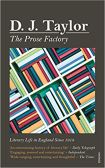Difference between revisions of "The Prose Factory by D J Taylor"
| Line 14: | Line 14: | ||
|isbn= 978-0099556077 | |isbn= 978-0099556077 | ||
|website= http://www.djtaylorwriter.co.uk | |website= http://www.djtaylorwriter.co.uk | ||
| − | |||
|cover=Taylor_Prose | |cover=Taylor_Prose | ||
|aznuk=0099556073 | |aznuk=0099556073 | ||
Latest revision as of 09:16, 5 May 2018
| The Prose Factory by D J Taylor | |
|
| |
| Category: Reference | |
| Reviewer: Kate Jones | |
| Summary: A thorough, interesting and sometimes quirky look at the world of writing, reading and publishing in the last Century. | |
| Buy? Yes | Borrow? Yes |
| Pages: 528 | Date: January 2017 |
| Publisher: Vintage | |
| External links: Author's website | |
| ISBN: 978-0099556077 | |
|
| |
D J Taylor's exploration of writing, reading, publishing and critical reviews spans a century of literary history, discussing everything from Eliot-era modernists and Georgian traditionalists, to the impact of politics, creative writing degrees, reviewers and critics. It is a deep and thorough exploration of the multi-complex influences on English literary life over the past century and the way these have shaped readers' preferences and reading habits. But don't be put off by thinking that this is a dusty, encyclopaedic tome – it is a large book at around 500 pages – but it is accessible and thoroughly readable.
The book is split into three sections: Tradition and Dissent; Citadels of Power; and The Modern Age, and is something anybody with an interest in literature will want to dip in and out of, discovering gems of interest. Similarly, it would be of use to anybody studying English Literature and in particular, trends in reading, publishing and literary criticism.
Dotted between the pages of the book are a couple of sections of black and white photographs of writers, critics and original book covers, and even some satirical cartoons taken from newspapers of the time, which I felt was a nice touch.
Taylor clearly knows his subject matter and his passion shines through the narrative. A particularly interesting and original part of the book, for me, were the chapters entitled 'Making a Living', of which there are three, covering the periods 1918-1939, 1939-1970, and 1970 - . I thought this an interesting diversion, wherein Taylor compares famous and celebrated author's earnings for the periods, some of which are very surprising. At the front of the book, he helpfully explains how these convert to modern equivalents.
Another section I particularly enjoyed was the chapter entitled 'Lady Writers'. Though the title may sound at first glance demeaning, it is a tongue-in-cheek look at the trepidation and dismay some male writers and critics felt at the arrival of more women writers on the publishing scene. In particular, an outline taken from the Spectator by Simon Reeve, addressed to his fellow (male) novelists on the menace of the sixties – the contemporary woman writer. My only complaint here would be that I'd have liked this section to be longer: it is very short in comparison to the 'New Man' chapter earlier in the book, which explores men's writing in far more depth.
All in all, this is an enjoyable, delve in and out of, in-depth and original take on the life of writers and writing, and I would highly recommend to anybody studying the subject, or anyone with just an interest in the workings of the literary world.
If you like this, you might enjoy: Lost, Stolen or Shredded: Stories of missing works of art and literature by Rick Gekoski.
{{amazontext|amazon=0099556073}
![]() You can read more book reviews or buy The Prose Factory by D J Taylor at Amazon.com.
You can read more book reviews or buy The Prose Factory by D J Taylor at Amazon.com.
Comments
Like to comment on this review?
Just send us an email and we'll put the best up on the site.


